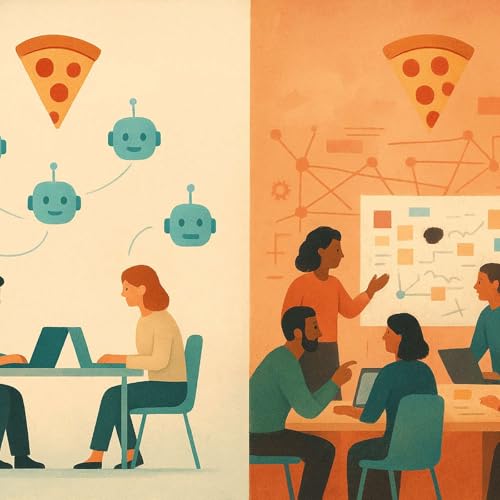
One Pizza Teams vs Two Pizza Teams: When Size Actually Matters
カートのアイテムが多すぎます
ご購入は五十タイトルがカートに入っている場合のみです。
カートに追加できませんでした。
しばらく経ってから再度お試しください。
ウィッシュリストに追加できませんでした。
しばらく経ってから再度お試しください。
ほしい物リストの削除に失敗しました。
しばらく経ってから再度お試しください。
ポッドキャストのフォローに失敗しました
ポッドキャストのフォロー解除に失敗しました
-
ナレーター:
-
著者:
このコンテンツについて
Can AI really shrink your development teams from two pizzas to one? Peter and Dave explore the promise and reality of smaller teams in the age of AI agents. While AI can handle documentation, test automation, and other "hygiene" tasks teams often skip, the real question isn't whether you can reduce team size, it's whether you should. They dig into when one-person teams make sense (startups and greenfield projects), when they don't (complex legacy systems), and why the biggest gains might come from augmenting existing teams rather than downsizing them. Plus: why most AI initiatives fail and how to find the real business problems worth solving.
This week´s Takeaways
- AI as Capacity Booster, Not Team Replacer: AI agents excel at handling the "hygiene" work that teams often skip: documentation, test automation, release notes. Rather than shrinking teams, this gives existing teams ephemeral capacity to tackle work that improves long-term system quality and maintainability.
- Context Determines Team Size: One-person teams work brilliantly for startups and greenfield projects where you can build from scratch. But complex legacy systems in large organizations still need the diverse knowledge and experience that comes with larger teams to navigate technical debt and organizational complexity.
- Solve Real Business Problems First: The biggest AI failures happen when teams focus on cool technology instead of actual business needs. Before experimenting with smaller teams or AI agents, identify genuine business problems that need solving; that's where you'll see real returns and organizational support.
まだレビューはありません


